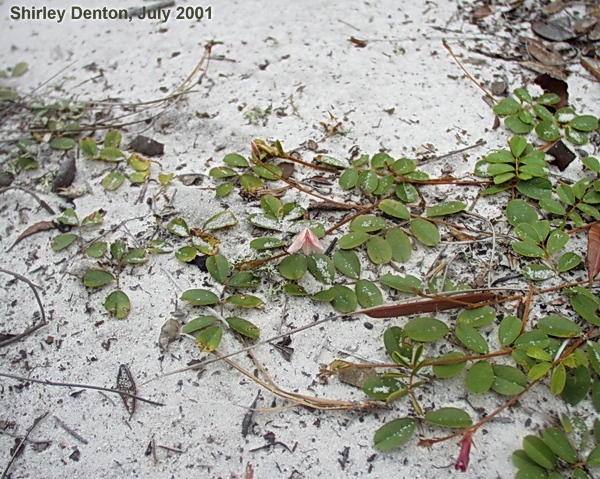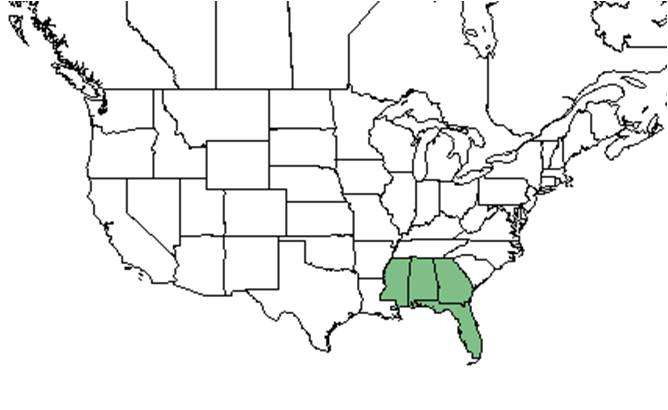Difference between revisions of "Tephrosia chrysophylla"
Juliec4335 (talk | contribs) |
(→Description) |
||
| Line 25: | Line 25: | ||
<!-- Basic life history facts such as annual/perrenial, monoecious/dioecious, root morphology, seed type, etc. --> | <!-- Basic life history facts such as annual/perrenial, monoecious/dioecious, root morphology, seed type, etc. --> | ||
Perennial herbs, stems woody below, or from woody crown or caudex. Taproot present. Nodules present. Stems prostrate, trailing, or mat forming, less than 1 m tall. Stems solid, sparsely to densely hairy, stem hairs hispid to villous. Stipules inconspicuous, absent, or caducous; setiform, subulate or acicular; persistent, free. Leaves alternate, petiolate, compound, odd pinnate, leaf or leaflet margins entire, opposite, 5-9 in number, hairy on one or both surfaces. Inflorescences are racemes, terminal, leaf-opposed. Bracts conspicuously present. Flowers zygomorphic. Calyx 5-lobed, hairy. Petals separate, clawed, color white, pinkish to rose, blue, lavender to purple, or violet, though typically white in the sandhills of northern Florida, bicolored or with red, purple or yellow streaks or spots, typically pink stripes in the sandhills of northern Florida. Banner petal ovoid or obovate, petal suborbicular, broadly rounded. Wing petals narrow, oblanceolate to oblong, auriculate. Wing tips obtuse or rounded. Keel petals auriculate, spurred, or gibbous. Keel tips obtuse or rounded, not beaked. Stamens 9-10, diadelphous, 9 united, 1 free. Filaments glabrous. Style terete, sharply bent, hairy on one side only. Fruit a legume, unilocular, freely dehiscent, elongate, straight, exserted from calyx. Valves twisting or coiling after dehiscence. Fruit beaked, hairy, 3-10 seeded. Seeds ovoid to rounded in outline, surface smooth, color olive, brown, or black, surface mottled or patchy.<ref name="eol">[[http://eol.org/pages/418086/details]]Encyclopedia of Life. Accessed: March 17, 2016</ref> | Perennial herbs, stems woody below, or from woody crown or caudex. Taproot present. Nodules present. Stems prostrate, trailing, or mat forming, less than 1 m tall. Stems solid, sparsely to densely hairy, stem hairs hispid to villous. Stipules inconspicuous, absent, or caducous; setiform, subulate or acicular; persistent, free. Leaves alternate, petiolate, compound, odd pinnate, leaf or leaflet margins entire, opposite, 5-9 in number, hairy on one or both surfaces. Inflorescences are racemes, terminal, leaf-opposed. Bracts conspicuously present. Flowers zygomorphic. Calyx 5-lobed, hairy. Petals separate, clawed, color white, pinkish to rose, blue, lavender to purple, or violet, though typically white in the sandhills of northern Florida, bicolored or with red, purple or yellow streaks or spots, typically pink stripes in the sandhills of northern Florida. Banner petal ovoid or obovate, petal suborbicular, broadly rounded. Wing petals narrow, oblanceolate to oblong, auriculate. Wing tips obtuse or rounded. Keel petals auriculate, spurred, or gibbous. Keel tips obtuse or rounded, not beaked. Stamens 9-10, diadelphous, 9 united, 1 free. Filaments glabrous. Style terete, sharply bent, hairy on one side only. Fruit a legume, unilocular, freely dehiscent, elongate, straight, exserted from calyx. Valves twisting or coiling after dehiscence. Fruit beaked, hairy, 3-10 seeded. Seeds ovoid to rounded in outline, surface smooth, color olive, brown, or black, surface mottled or patchy.<ref name="eol">[[http://eol.org/pages/418086/details]]Encyclopedia of Life. Accessed: March 17, 2016</ref> | ||
| + | |||
| + | The root system of ''Tephrosia chrysophylla'' includes stem tubers which store non-structural carbohydrates (NSC) important for both resprouting following fire and persisting during long periods of fire exclusion.<ref name="Diaz"> Diaz-Toribio, M.H. and F. E. Putz 2021. Underground carbohydrate stores and storage organs in fire-maintained longleaf pine savannas in Florida, USA. American Journal of Botany 108: 432-442.</ref> Diaz-Toribio and Putz (2021) recorded this species to have an NSC concentration of 257.9 mg/g (ranking 16 out of 100 species studied) and water content of 22.8 % (ranking 16 out of 100 species studied).<ref name = "Diaz"/> | ||
==Distribution== | ==Distribution== | ||
Revision as of 20:03, 12 May 2021
| Tephrosia chrysophylla | |
|---|---|

| |
| Photo by Shirley Denton (Copyrighted, use by photographer’s permission only), Nature Photography by Shirley Denton | |
| Scientific classification | |
| Kingdom: | Plantae |
| Division: | Magnoliophyta - Flowering plants |
| Class: | Magnoliopsida – Dicotyledons |
| Order: | Fabales |
| Family: | Fabaceae ⁄ Leguminosae |
| Genus: | Tephrosia |
| Species: | T. chrysophylla |
| Binomial name | |
| Tephrosia chrysophylla Pursh | |

| |
| Natural range of Tephrosia chrysophylla from USDA NRCS Plants Database. | |
Common names: Scurf hoarypea, Sprawling goat's-rue
Contents
Taxonomic notes
Synonyms: Cracca chrysophylla (Pursh) Kuntze; Cracca carpenteri Rydberg; Cracca chapmanii (Vail) Small
Description
Perennial herbs, stems woody below, or from woody crown or caudex. Taproot present. Nodules present. Stems prostrate, trailing, or mat forming, less than 1 m tall. Stems solid, sparsely to densely hairy, stem hairs hispid to villous. Stipules inconspicuous, absent, or caducous; setiform, subulate or acicular; persistent, free. Leaves alternate, petiolate, compound, odd pinnate, leaf or leaflet margins entire, opposite, 5-9 in number, hairy on one or both surfaces. Inflorescences are racemes, terminal, leaf-opposed. Bracts conspicuously present. Flowers zygomorphic. Calyx 5-lobed, hairy. Petals separate, clawed, color white, pinkish to rose, blue, lavender to purple, or violet, though typically white in the sandhills of northern Florida, bicolored or with red, purple or yellow streaks or spots, typically pink stripes in the sandhills of northern Florida. Banner petal ovoid or obovate, petal suborbicular, broadly rounded. Wing petals narrow, oblanceolate to oblong, auriculate. Wing tips obtuse or rounded. Keel petals auriculate, spurred, or gibbous. Keel tips obtuse or rounded, not beaked. Stamens 9-10, diadelphous, 9 united, 1 free. Filaments glabrous. Style terete, sharply bent, hairy on one side only. Fruit a legume, unilocular, freely dehiscent, elongate, straight, exserted from calyx. Valves twisting or coiling after dehiscence. Fruit beaked, hairy, 3-10 seeded. Seeds ovoid to rounded in outline, surface smooth, color olive, brown, or black, surface mottled or patchy.[1]
The root system of Tephrosia chrysophylla includes stem tubers which store non-structural carbohydrates (NSC) important for both resprouting following fire and persisting during long periods of fire exclusion.[2] Diaz-Toribio and Putz (2021) recorded this species to have an NSC concentration of 257.9 mg/g (ranking 16 out of 100 species studied) and water content of 22.8 % (ranking 16 out of 100 species studied).[2]
Distribution
Florida, Georgia, Alabama, and Mississippi. Critically imperiled in Georgia.[3]
Ecology
Habitat
In the Coastal Plain, T. chrysophylla habitats include longleaf pine-oak-wiregrass woodlands, sand pine scrubs, pine/wiregrass communities, scrub oak wiregrass sandhills, and upland turkey oak longleaf pinewoods. It has been found in disturbed areas such as along logging roads, a clear cut disturbed longleaf pine scrub oak ridge, an open sand ridge plowed three years previously, a bulldozed clearing in turkey oak longleaf pine, a sandy old quarry, a clobbered slash pine forest, and coarse sandy clearing of longleaf pine scrub oak barren. Soil types include loamy sand, sand, and sandy peat.[4] Associated species include Balduina angustifolia, Dalea feayi, and Polygonella robusta.[5] In Central Florida T. chrysophylla exhibited no significant response to soil disturbance by some clearcutting, brack seeding, high-severity burns, and salvage logging. However, it responded positively to soil disturbance by some clearcutting, single roller chopping, and broadcast seeding.[6] T. chrysophylla responds negatively to soil disturbance by roller chopping in Northwest Florida sandhills.[7]
Tephrosia chrysophylla is an indicator species for the Peninsula Xeric Sandhills community type as described in Carr et al. (2010).[8]
Phenology
T. chrysophylla has been observed to flower June through September with peak inflorescence in August and fruiting May through October.[4][9]
Fire ecology
It has been observed growing in burned pine flatwoods.[4]
Pollination
The following Hymenoptera families and species were observed visiting flowers of Tephrosia chrysophylla at Archbold Biological Station: [10]
Halictidae: Nomia maneei
Megachilidae: Megachile brimleyi, M. georgica
Flowers develop pink striation after being pollinated.[11]
Conservation and management
Cultivation and restoration
Photo Gallery
References and notes
Florida State University Robert K. Godfrey Herbarium database. URL: http://herbarium.bio.fsu.edu. Last accessed: November 2015. Collectors: Loran C. Anderson, A.F. Clewell, M. Davis, Robert K. Godfrey, Ann F. Johnson, R. Komarek, Robert Kral, Robert L. Lazor, K. MacClendon, R.S. Mitchell, Gwynn W. Ramsey, H.R. Reed, Grady W. Reinert, Cecil R. Slaughter, John K. Small, D.B. Ward States and Counties: Alabama: Covington, Geneva. Florida: Calhoun, Citrus, Dixie, Duval, Escambia, Franklin, Gadsden, Gilchrist, Gulf, Hernando, Highlands, Leon, Liberty, Okaloosa, Putnam, Suwannee, Taylor, Wakulla, Walton. Georgia: Grady. Mississippi: Poplarville. Compiled by Tall Timbers Research Station and Land Conservancy.
- ↑ [[1]]Encyclopedia of Life. Accessed: March 17, 2016
- ↑ 2.0 2.1 Diaz-Toribio, M.H. and F. E. Putz 2021. Underground carbohydrate stores and storage organs in fire-maintained longleaf pine savannas in Florida, USA. American Journal of Botany 108: 432-442.
- ↑ [[2]]NatureServe. Accessed: March 17, 2016
- ↑ 4.0 4.1 4.2 Florida State University Robert K. Godfrey Herbarium database. URL: http://herbarium.bio.fsu.edu. Last accessed: November 2015. Collectors: Loran C. Anderson, A.F. Clewell, M. Davis, Robert K. Godfrey, Ann F. Johnson, R. Komarek, Robert Kral, Robert L. Lazor, K. MacClendon, R.S. Mitchell, Gwynn W. Ramsey, H.R. Reed, Grady W. Reinert, Cecil R. Slaughter, John K. Small, D.B. Ward States and Counties: Alabama: Covington, Geneva. Florida: Calhoun, Citrus, Dixie, Duval, Escambia, Franklin, Gadsden, Gilchrist, Gulf, Hernando, Highlands, Leon, Liberty, Okaloosa, Putnam, Suwannee, Taylor, Wakulla, Walton. Georgia: Grady. Mississippi: Poplarville. Compiled by Tall Timbers Research Station and Land Conservancy.
- ↑ [[3]]idigbio. Accessed: March 16, 2016
- ↑ Greenberg, C.H., D.G. Neary, L.D. Harris, and S.P. Linda. (1995). Vegetation Recovery Following High-intensity Wildfire and Silvicultural Treatments in Sand Pine Scrub. American Midland Naturalist 133(1):149-163.
- ↑ Hebb, E.A. (1971). Site Preparation Decreases Game Food Plants in Florida Sandhills. The Journal of Wildlife Management 35(1):155-162.
- ↑ Carr, S.C., K.M. Robertson, and R.K. Peet. 2010. A vegetation classification of fire-dependent pinelands of Florida. Castanea 75:153-189.
- ↑ Nelson, G. PanFlora: Plant data for the eastern United States with emphasis on the Southeastern Coastal Plains, Florida, and the Florida Panhandle. www.gilnelson.com/PanFlora/ Accessed: 14 DEC 2016
- ↑ Deyrup, M.A. and N.D. 2015. Database of observations of Hymenoptera visitations to flowers of plants on Archbold Biological Station, Florida, USA.
- ↑ Campbell, Joshua. Observation posted to Florida Flora and Ecosystematics Facebook Group on October 8, 2016.